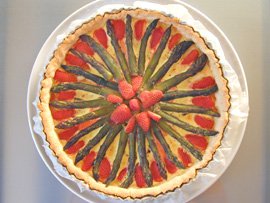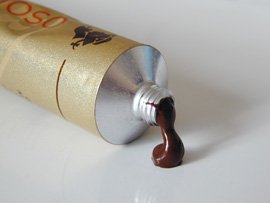
[Asparagus and Strawberry Tart]
About a year ago, a little group of us Parisian (by birth or by heart) food enthusiasts started a tradition of organizing potluck dinners at one another’s place. On Saturday night, my dear friend Alisa hosted her second such event, setting Aphrodisiac Foods as the theme for the night. The event had been scheduled for a while and I had done some basic research about those ingredients that were notable aphrodisiacs, but somehow I could not get the culinary half of my brain to think further than “ginger”. Thankfully, a couple of days before the event, inspiration struck.
I was reading the handy list at GourmetSleuth and two ingredients jumped at me, begging to be finally paired off after years of secret yearning — Mr. Asparagus and Ms. Strawberry. One green one red, one slender one squat, both bringing into the relationship their own subtly sweet taste and personable texture. I decided to lay them on a bed of almond pâte brisée (almonds symbolize fertility) and call it an Asparagus and Strawberry Tart.
For the crust I started with the perfect pâte brisée recipe I got from Pascale, substituting almond powder for a quarter of the flour. This and the butter formed a nicely supple — if a little soft — ball of dough, to which the addition of an egg (as the original recipe calls for) was unnecessary. The asparagus were steamed, the strawberries cleaned and quartered, and a simple batter of crème fraîche and eggs formed the sheeting on which I arranged the couple, in as aesthetic a pattern as I could, before I gave them a little oven privacy.
To my glee, the tart was very well received: its crust was light and flaky, the asparagus/strawberry pairing worked superbly and the whole thing vanished in no time. There were about twenty of us, and the contributions were as varied and delicious as oysters with ginger sauce, grilled asparagus, sesame tuna tartare, lapin à la moutarde (rabbit in mustard and white wine), frogs’ legs in parsley butter, pistachio tabouli or arugula salad.
The dessert spread did not disappoint either, boasting a chocolate fondue and a mountain of strawberries, brownies topped with candied almonds, a cream cake flavored with tonka beans and artfully decorated with homemade and cute breast-shaped mini-meringues, figs served with a crystallized ginger cream, and chocolate mini-financiers flavored with long pepper and ginger.
And before you ask, my story does not (and will not) discuss the relative merit and efficiency of the aforementioned aphrodisiac dishes — some things are just better left unsaid.







